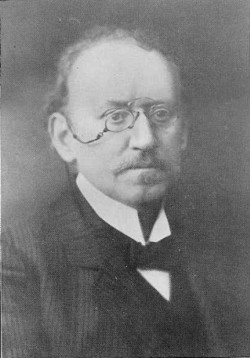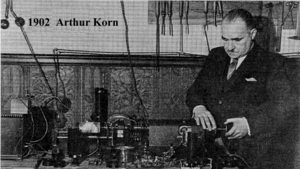Arthur Korn facts for kids
Quick facts for kids
Arthur Korn
|
|
|---|---|
 |
|
| Born | 20 May 1870 |
| Died | 22 December 1945 (aged 75) |
| Nationality | German |
| Occupation | Physicist, mathematician, Inventor |
Arthur Korn was a German scientist born in 1870. He was a physicist, mathematician, and inventor. He is famous for his work on the fax machine. He helped create ways to send pictures over long distances. This was called "telephotography" or the "Bildtelegraph." His work also helped with early ideas for mechanical television.
Contents
Early Life and Education
Arthur Korn was born in Breslau, Germany, on May 20, 1870. His parents were Moritz and Malwine Schottlaender. He went to high school in Breslau and Berlin.
He started studying physics and mathematics at the University of Leipzig when he was just 15 years old. He finished his studies there in 1890. After that, he continued learning in big cities like Berlin, Paris, London, and Würzburg.
A Career in Science
In 1895, Arthur Korn became a teacher at the University of Munich. He taught about the laws of physics. By 1903, he became a full professor. In 1914, he moved to the Berlin Institute of Technology to lead the physics department.
Later in his life, in 1935, Arthur Korn had to leave his job. This was because of the political changes happening in Germany. In 1939, he and his family moved to the United States. He became a professor of physics and mathematics at Stevens Institute of Technology in New Jersey. He passed away in 1945 in Jersey City, New Jersey.
Sending Pictures Over Distances
Arthur Korn was a true pioneer in sending images over long distances. He worked on a system called the "phototelautograph." He was one of the first to use special light-sensitive cells made of selenium. These cells helped to capture and send images. He also used a special light source called a Nernst lamp.
On October 17, 1906, he made a big breakthrough. He sent a photograph of Crown Prince William over a distance of 1,800 kilometers (about 1,118 miles)! This was a huge step for communication.
Famous Transmissions
In 1913, at a meeting in Vienna, Korn showed something amazing. He successfully sent a moving picture (like a short film) using his telegraph system.
One of his most famous achievements happened in 1923. He successfully sent an image of Pope Pius XI all the way across the Atlantic Ocean. The picture traveled from Rome to Bar Harbor, Maine, in the United States. People called this a "miracle of modern science"!
His technology was very useful. From 1928, the German police used Korn's system to send photographs and fingerprints. This helped them catch criminals faster. Even earlier, in 1907, his "phototelegraph" helped catch a thief from a Stuttgart bank in London. Newspapers also used his technology to send pictures quickly.
Arthur Korn also studied other areas of science. He worked on "potential theory" and the mathematics behind physics. He was invited to speak at important math conferences in Rome (1908) and Zürich (1932).
See also
 In Spanish: Arthur Korn para niños
In Spanish: Arthur Korn para niños
- History of television
- Mechanical television
- German inventors and discoverers
- Granino A. Korn, son
- Theresa M. Korn, daughter-in-law and biographer of Arthur Korn


